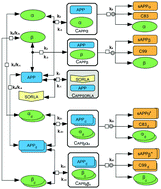Stability analysis of the ODE model representation of amyloidogenic processing in Alzheimer's disease in the presence of SORLA†
Abstract
The proteolytic breakdown of the amyloid precursor protein (APP) by secretases is a complex cellular process that results in the formation of neurotoxic Aβ peptides, causative of neurodegeneration in Alzheimer's disease (AD). Processing involves monomeric and dimeric forms of APP that are transported through distinct cellular compartments where the various secretases reside. Amyloidogenic processing is also influenced by modifiers such as sorting receptor-related protein (SORLA), an inhibitor of APP breakdown and a major AD risk factor. This paper analyzed the temporal behavior of a mathematical model describing APP processing under the influence of SORLA, by performing a stability analysis of the mathematical model. We found one biochemically meaningful equilibrium point ξ. By means of linearization, Hartman–Grobman theorem, and Routh–Hurwitz test, it was shown that ξ is a locally asymptotically stable equilibrium point. The region of attraction of ξ was approximated by using the fluctuation lemma. An immediate consequence of the stability analysis of the reduced system to the temporal behavior of the solutions of the original system was also obtained. The biological implications of these results for the dynamic behavior of the activity of APP and secretases under SORLA's influence were established.


 Please wait while we load your content...
Please wait while we load your content...